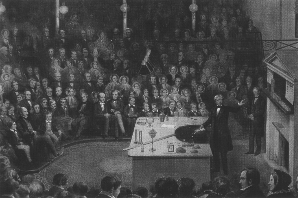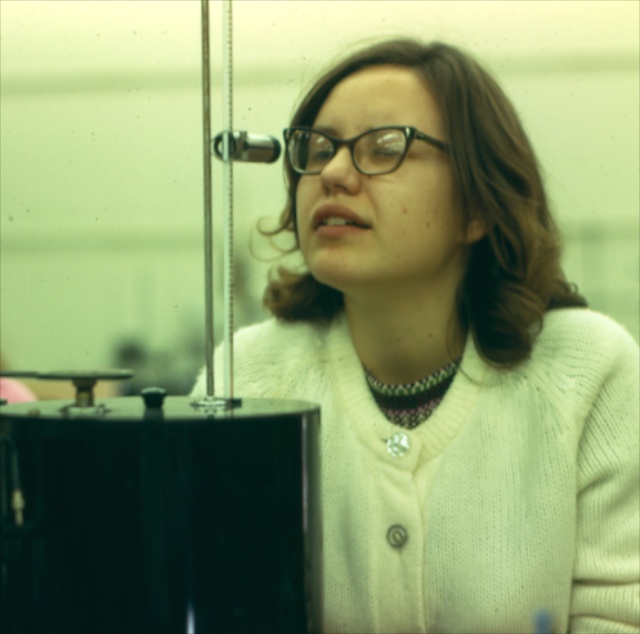
Natural Science - Year I
Unit 3: Humidity Lab

Lab Assignment for Unit 3
| This Unit's | Homework Page | History Lecture | Science Lecture | Lab | Parents' Notes |
Natural Science Unit 3 Laboratory Activity:
Weather Observations — Humidity
Goal: To determine relative humidity in the atmosphere.
Materials and Equipment:
- A milk carton or plastic waterproof container, or any other container where you can position one of the thermometers so that you can keep its bulb wet.
- Two thermometers
- A strip of absorbant cloth, like a piece of washcloth
- Rubber bands or soft wire
Procedure:

- Note:This experiment takes at least 12 hours to set up and run. Once it is set up, you will need to make readings every hour. Plan accordingly!
- Punch a hole in your container least 2 inches from the bottom.
- Fill the container to the hole with water.
- Using rubber bands or wire, attach one thermometer to a side of the carton so that its bulb is just above the hole. Attach the second thermometer to a different side of the container, but at the same level (so that its bulb is level with the hole).
- Wrap the bulb of the thermometer next to the hole with the strip of cloth, and push the end of the cloth through the hole and into the water. The cloth should become wet and keep the base of this thermometer damp.
- Close the container if possible to decrease the rate of evaporation from inside the carton. Set the carton so that you can read both thermometers without moving the carton.
- Record the current weather conditions: what kind of cloud cover do you have? Is there any precipitation?
- Make a table with three columns. In the first column, you will record the time of day. In the second column, record the temperature on the "wet bulb" thermometer. In the third column, record the temperature on the "dry bulb" thermometer:
Time Wet Bulb Dry Bulb Relative Humidity 9 am 60 70 ____55________ 10 am 46 70 _____6_________ - Take readings at least once an hour for twelve hours. Make sure that your eye is level with the height of the alcohol or mercury column, so that you don't misread the column label.
- Record the weather conditions at the end of your humidity observation period.
- Calculations:
- Look up the wet bulb and dry bulb temperatures on the relative humidity table below, and record the relative humidity in the rightmost column.
Wet-Bulb Temperatures in Degrees Fahrenheit Dry-Bulb Temperatures in Degrees Fahrenheit 56 58 60 62 64 66 68 70 71 72 73 74 75 76 77 78 79 80 82 84 86 88 38 7 40 15 11 7 42 25 19 14 9 7 44 34 29 22 27 13 8 4 46 45 38 30 24 18 14 10 6 4 3 1 48 55 47 40 33 26 21 16 12 10 9 7 5 4 3 1 50 66 56 48 41 34 29 23 19 17 15 13 11 9 8 6 5 4 3 52 77 67 57 50 43 36 31 25 23 21 19 17 15 13 12 10 9 7 5 3 1 54 88 78 68 59 51 44 38 33 30 28 25 23 21 19 17 16 14 12 10 7 5 3 56 89 79 68 60 53 46 40 37 34 32 29 27 25 23 21 19 18 14 12 9 7 58 89 79 70 61 54 48 45 42 39 36 34 31 29 27 25 23 20 16 14 11 60 90 79 71 62 55 52 49 46 43 40 38 35 33 31 29 25 21 18 15 62 90 80 71 64 60 57 53 50 47 44 42 39 37 35 30 26 23 20 64 90 80 72 68 65 61 58 54 51 48 46 43 41 36 32 28 25 66 90 81 77 73 69 65 62 59 56 53 50 47 42 37 33 30 68 90 86 82 78 74 70 66 63 60 57 54 48 43 39 35 70 95 91 86 82 78 74 71 67 64 61 55 49 44 40 72 95 91 86 82 79 75 71 68 61 56 50 46 74 96 91 87 83 79 75 69 62 57 51 76 96 91 87 83 76 69 63 57 78 96 91 84 76 70 64 80 92 84 77 70 82 92 84 77 84 92 85 86 92
- Look up the wet bulb and dry bulb temperatures on the relative humidity table below, and record the relative humidity in the rightmost column.
Data Analysis:
- Determine whether the humidity is increasing or decreasing. Make a prediction for the next day's weather, based on your humidity readings and other weather information.
- Check your local weather report and record the official temperature, humidity, and general weather conditions. How do your observations compare with the reported conditions?
- On the next day, record temperature, humidity, and general weather conditions (fair, windy, precipitation). Was your prediction accurate?
Report:
- Review the example lab report in the Student Survival Guide. Prepare your report. It should include:
- A list of your equipment, including instructions on how to make any equipment that you built yourself.
- An outline of the procedures that you used to make measurements or observations, in enough detail that another student could duplicate your observations.
- Your wet and dry bulb temperature data in a data table, along with your calculations of relative humidity.
- Your conclusions about whether humidity is increasing or decreasing, and your short-term weather prediction.
- An evaluation of the accuracy of your prediction, based on the actual weather for the two days following your experiment
- An evaluation of the accuracy of your data (could you read the temperature to 1°F? to 1/10°F?).
- Make at least one suggestion for improving your data collection.
Upload your Lab report to the Lab Assignment for Humidity observations at the Moodle Natural Science homepage.
© 2005 - 2024 This course is offered through Scholars Online, a non-profit organization supporting classical Christian education through online courses. Permission to copy course content (lessons and labs) for personal study is granted to students currently or formerly enrolled in the course through Scholars Online. Reproduction for any other purpose, without the express written consent of the author, is prohibited.